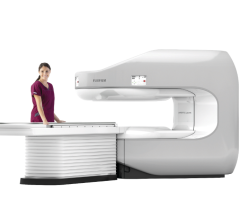
October 21, 2015 — Agfa HealthCare announced it is launching its new Enterprise Imaging platform that simplifies the creation of a single comprehensive patient imaging record. The software empowers physicians to make informed decisions through multi-specialty collaboration, helping improve delivery of patient care and streamlining costs. Providing a modular approach to building and deploying, it enables organizations to move at their own pace to fulfill their enterprise strategy.
Hospitals can start from a variety of points, including enterprise viewing, image capture, storage, universal access via a healthcare portal or diagnostic departmental solutions, to ultimately achieve the complete medical imaging solution.
While images are an integral part of any patient record and treatment path, they are often not accessible outside of the place of acquisition. The Enterprise Imaging platform comprises all the workflows and tools needed to consolidate and disseminate the patient's electronic imaging record. Bringing together clinical data with Enterprise Imaging completes the entire electronic health record (EHR) and the patient's longitudinal record. Physicians and patients alike can access images via the secure portal, while specialized tools and workflows for departments such as radiology, cardiology, orthopedics, dermatology, ophthalmology and nursing care reach throughout the enterprise to provide departmental depth. It also enhances collaboration all along the care continuum, using virtual, real-time collaboration and sharing tools that fit today's healthcare enterprise model.
The platform offers many areas for hospitals to save on and control costs. The vendor neutral archive (VNA) puts an end to information silos, while Information Lifecycle Management enhances effective information management. Data are synchronized, saving time and effort, and enhancing data integrity.
The consolidated IT infrastructure leverages existing investments, eliminating unnecessary costs and supporting the hospital's long-term strategy, and reduces the total cost of ownership. Simplified deployment across multiple facilities using a local proxy servier allows a shared workflow engine across facilities. To further control costs, Enterprise Imaging can be hosted by Agfa HealthCare as a software-as-a-service (SaaS). Day-to-day management is taken care of, with predictable and all-inclusive service costs, including high availability and disaster recovery. On-premises proxy services are also available.
Enterprise Imaging can help enterprises uncover new billable services, while fast and easy coding for diagnostic and billing codes for each procedure facilitates billing and allows data mining, as well as a split-cost VNA.
The Enterprise Imaging platform offers new visual online collaboration tools, including chat, share and more. Organizing and participating in multi-disciplinary meetings and clinical conferences is straightforward and efficient.
Reporting is less complex and more readable. For radiology, sectional reporting is used; radiologists can add measurements and key images directly into the report, and flag critical findings easily. For cardiologists, next-generation structured reporting modules give support for non-invasive cardiac and vascular ultrasound reporting.
Enterprise Imaging fits today's mobile work environment. With the zero footprint image viewer, caregivers can view (and upload) multimedia images and reports and have the option of full-fidelity diagnostic view. An intuitive patient timeline provides a thumbnail-enabled, study-by-study, unified view of the patient's images. Web-based collaboration is easy and clinical specialty tools are available with XERO Xtend. The lightweight client allows editing and approval of reports remotely.
Enterprise Imaging provides all applications and services on a single modern IT platform, with 64-bit architecture that enables a single integration point into the EMR - and an end to imaging silos.
Standards-based, it offers true out-of-the box interoperability across major communication standards, and makes integration of new applications and modalities easy. Enterprise Imaging uses a multi-server configuration for scalability, availability and disaster recovery that can operate in a cluster mode and reach a higher load.
The single platform standardization allows the healthcare enterprise to realize workflow improvements and enables a task-based workflow. The intuitive features and tools are the same for all users across the enterprise, reducing training and operational costs and simplifying appointment scheduling.
The Enterprise Imaging platform acts as an innovation catalyst, offering enterprises new insights into their operations. Patients, staff and referring physicians alike see the benefits, enhancing stakeholder satisfaction. Patients enjoy a smoother, faster process and optimized care; access to their own images through the portal increases their engagement. Staff see faster patient turnaround and better collaboration, and have access to the specialized tools they need, as well as remote tools for when they are on call. Referring physicians have faster turnaround of orders, and quicker access to images and reports. They can also access the full patient record. And by monitoring and understanding the referring physician activity, the enterprise can better target communications to this key group. Value-driven care is supported, for optimized patient care.
The platform contains eight integrated solutions for creating a true enterprise imaging workflow:
- Enterprise Imaging for Radiology: The Enterprise Imaging portfolio has solutions for the radiology department as well as any other department that creates and uses imaging. Agfa's Enterprise Imaging for Radiology solution takes a distinct new approach to imaging management by delivering a unified imaging platform that provides PACS, reporting, advanced image processing and integration of clinical information all in one sophisticated platform.
- Enterprise Imaging for Cardiology: A unified imaging platform that includes picture archiving and communication systems (PACS), reporting, advanced image processing and integration of clinical information.
- Enterprise EHR imaging: Provides department modality acquisition and PACS data to EHR integration workflows. You can seamlessly open clinical images from any department or location directly inside the EHR.
- Regional health: Enterprise Imaging makes it easy to share, exchange and transfer cases with caregivers, wherever they are, including health information exchanges (HIEs), patients and their families.
- VNA: Enterprise Imaging is PACS-, storage- and platform-vendor neutral, and compliant with relevant IHE integration profiles. It supports enterprise archiving of DICOM and non-DICOM data.
- Image exchange: Clinical and diagnostic images can be exchanged through the hospital and regionally. MPI integration, HL7 interfaces, DICOM conformation interfaces and support of existing Web standards provide image access via the EHR for clinicians and patients.
- Universal View: Any stakeholder can view their relevant images, with no client software. All that’s needed is a commonly-used Internet browser and a modest network connection.
- Business Analytics: Enterprise Imaging Business Intelligence lets users easily access a wealth of information about their healthcare enterprise and its operations from a single database, in the form of business intelligence reports and tools that provide historical, current and predictive views of operations.
For more information: www.agfahealthcare.com


 August 06, 2024
August 06, 2024 








